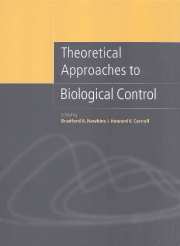Part I - Biological control theory: past and present
Published online by Cambridge University Press: 13 August 2009
Summary
The need to provide a conceptual foundation for biological control to support its empirical basis was realized by early workers. Indeed, the spectacular successes achieved by some early biological control projects directly stimulated the development of host–parasitoid theory in the 1930s. This legacy continues to the present, and population dynamic theory generated 60 years ago continues to form much of the theoretical basis of biological control. In Chapter 1, Berryman provides a cogent review of the historical development of ecological theory as it relates to biological control, focusing on discrete-time (difference) models that best describe systems in which the insects reproduce seasonally. Since biological control at its best is permanent and stable (in the sense that fluctuations in pest densities are heavily constrained over large geographic areas), the notion of ‘regulation’ is deeply ingrained in biological control theory. Berryman discusses regulation in the context of control theory and ecological engineering, engineering principles that share a large number of attributes with standard population dynamic theory. Although some biological control workers may be uncomfortable with the application of mechanical constructs to biological systems, all will readily recognize the overlap between the underlying principles of control theory and ecological theory. Perhaps fewer will be familiar with the state of predator–prey theory. An increasingly intense debate has been developing in recent years concerning whether predator–prey dynamics is best described by the long-standing ‘prey–dependent’ models or by ‘ratio-dependent’ models.
- Type
- Chapter
- Information
- Theoretical Approaches to Biological Control , pp. 1 - 2Publisher: Cambridge University PressPrint publication year: 1999



